When it comes to planning a project, the work breakdown structure is one of the first things a project manager has to work on.
In this guide, we will explain what is a work breakdown structure (WBS), how to create one and give you access to WBS templates for several scenarios. You can edit and export them as SVGs and images or share them with colleagues for collaboration.
1) What is a Work Breakdown Structure?
2) Benefits of Using Work Breakdown Structures in Project Management
3) Components of a Work Breakdown Structure
4) Rules You Need to Stick by When Designing a WBS
5) How to Create a Work Breakdown Structure
6) Common Mistakes to Avoid when Creating a Work Breakdown Structure
7) Work Breakdown Structure Templates
What is a Work Breakdown Structure?
A work breakdown structure is a popular project management tool. It’s a diagram that helps break down large projects into smaller and more manageable parts which contain the project deliverables or outcomes that it will complete.
It’s a deliverables-oriented breaking down of a project that divides project deliverables into sub-deliverables and work packages which define the work, duration and costs for the tasks that need to be carried out.
It has a hierarchical structure. Usually, it’s better to have three levels of decomposition in a WBS. In the case of a more complex project, you may add a fourth and a fifth level.
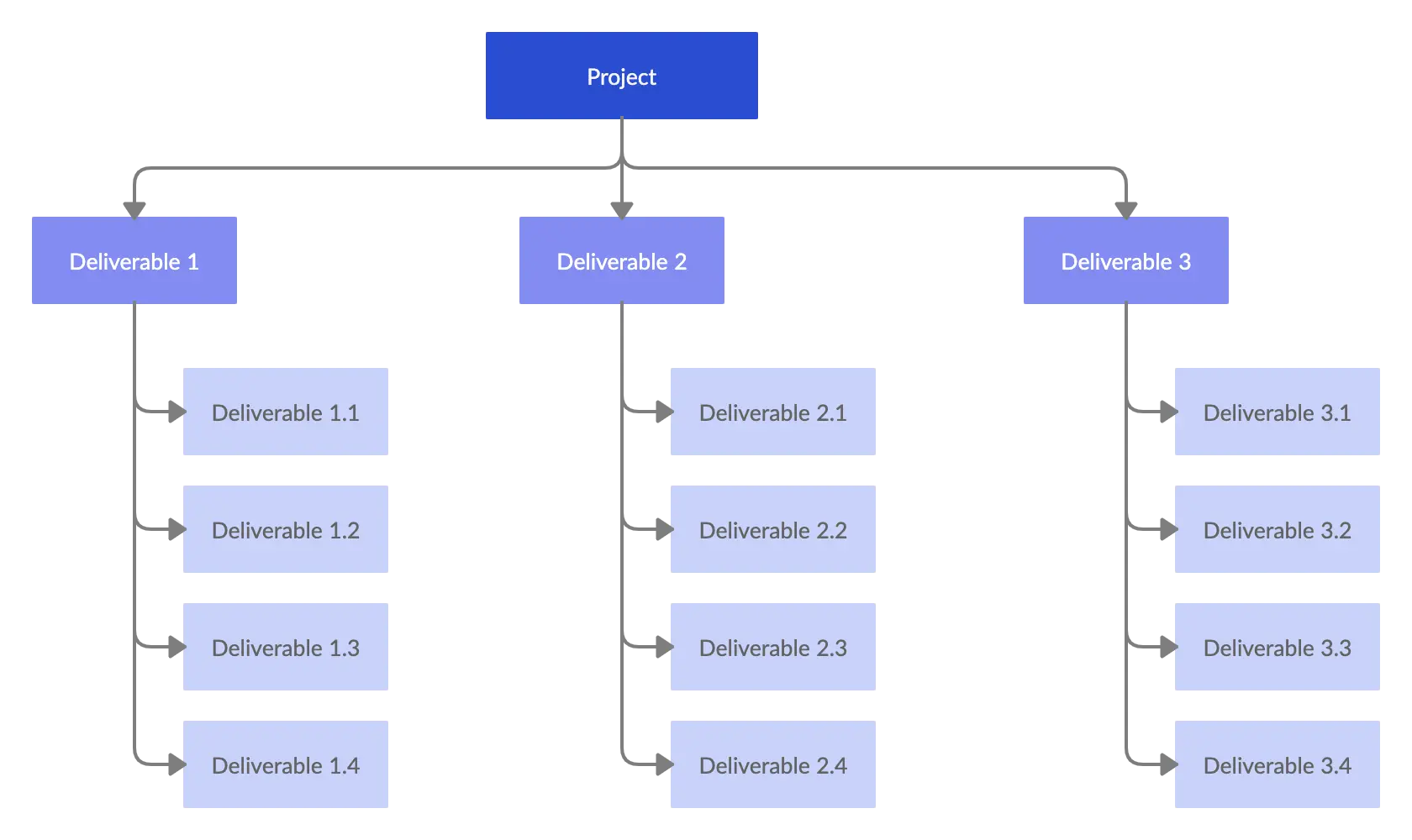
Benefits of Using Work Breakdown Structures in Project Management
- Visualizes the scope of the project, making it easier to do the planning
- Makes it easier to assign responsibilities accurately to the project team
- Helps with identifying the project milestones and control points
- Helps with estimating the time and cost for the project and allocate resources
- Visualizes important parts of a project and helps identify areas of risk
- Helps set clear timelines for the project and ensure that no work is duplicated or overlooked
Components of a Work Breakdown Structure
Following are the elements of a work breakdown structure and the common terms that you may come across when creating one.
Work packages: These are the lowest parts in a work breakdown structure. They define the work, duration, and costs for the tasks that need to be carried out to complete the deliverables. They shouldn’t be dependent on other work packages and should not exceed more than 10 days to complete.
Deliverables: Outcomes of the activities or the products or measurable outcomes you’ll have created at the end of each milestone.
Rules You Need to Stick by When Designing a WBS
Following are the principles you need to adhere to when designing a work breakdown structure.
The 100% rule: This rule helps the manager to ensure that all project efforts are captured and nothing unrelated is included in the structure. According to it the sum of the “child” tasks (on any level) must equal to 100% of the parent tasks.
All deliverables and sub-deliverables must be mutually exclusive, which means they shouldn’t appear twice within the work breakdown structure. This helps avoid miscommunication and duplication of tasks.
The 8/80 rule: According to this rule, the work packages or the work required to create the deliverables should not take less than eight hours and more than eighty hours.
The work breakdown structure must be focused on outcomes or deliverables and not the activities you need to complete to get there. Focus on the what and not the how.
How to Create a Work Breakdown Structure
Following we have listed the steps you need to take to create a work breakdown structure from scratch.
Step 1: Get your team together to identify the deliverables and sub-deliverables of the project. This would include the project managers and the subject matter experts.
Step 2: Gather the necessary documents such as the project charter, project scope statement, and project scope management plan.
Step 3: Identify the key deliverables of the project. These should come at the second level of your WBS. Key deliverables will be essential to the completion of the project and they will be carried out by independent teams – meaning the same team won’t be working on completing another deliverable.
Step 4: With the help of the subject matter experts, break the key deliverables into smaller parts of work (work packages) or in other words identify the work that is necessary to complete each deliverable.
Step 5: Create a WBS dictionary which is a document that includes the definition and the scope of the different elements in your work breakdown structure. The WBS dictionary would include information such as work package name and ID, name of the person it is assigned to, due date, estimated cost, etc. This will help the team understand work packages better.
Step 6. You can create a WBS using different formats like text-based work breakdown structures, tabular structures, or more visual ones like flowcharts. Once it is complete, share it with the team. A Creately work breakdown structure can be quickly shared with the rest of your team with a secure share link – once shared, you can collaborate on it in real-time.
Common Mistakes to Avoid when Creating a Work Breakdown Structure
Lack of detail: A common mistake is not breaking down the project into enough detail. Teams may create broad categories or tasks that are too large, which can lead to confusion and misunderstandings.
Overcomplicating the structure: While it’s important to have a detailed WBS, overcomplicating the structure can also be a mistake. This can happen when the team creates too many levels of subtasks or uses too many technical terms that not everyone on the team understands.
Not involving the right stakeholders: The WBS should be created by the project team, but it’s important to involve the right stakeholders in the process. This includes those who will be responsible for executing the tasks and those who will be impacted by the project.
Failing to account for dependencies: Teams need to identify the dependencies between tasks and ensure that they are reflected in the WBS. This can include tasks that can’t be started until another task is completed or tasks that need to be completed in a specific order.
Neglecting to update the WBS: A WBS is a living document that needs to be updated regularly to reflect changes in the project. Neglecting to update the WBS can lead to confusion and delays.
Work Breakdown Structure Templates
Work Breakdown Structure for Construction

Work Breakdown Structure for Project Management
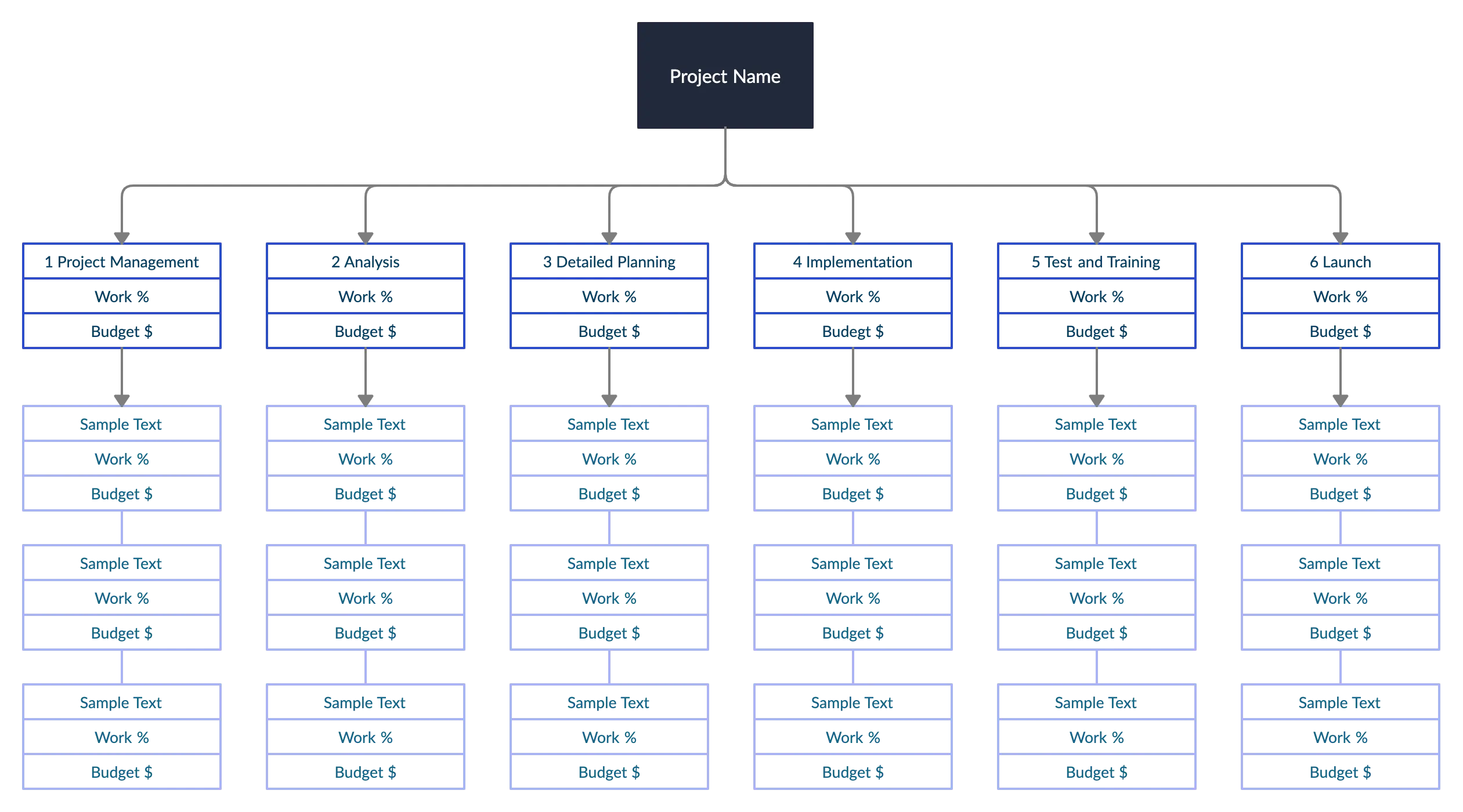
Work Breakdown Structure Template
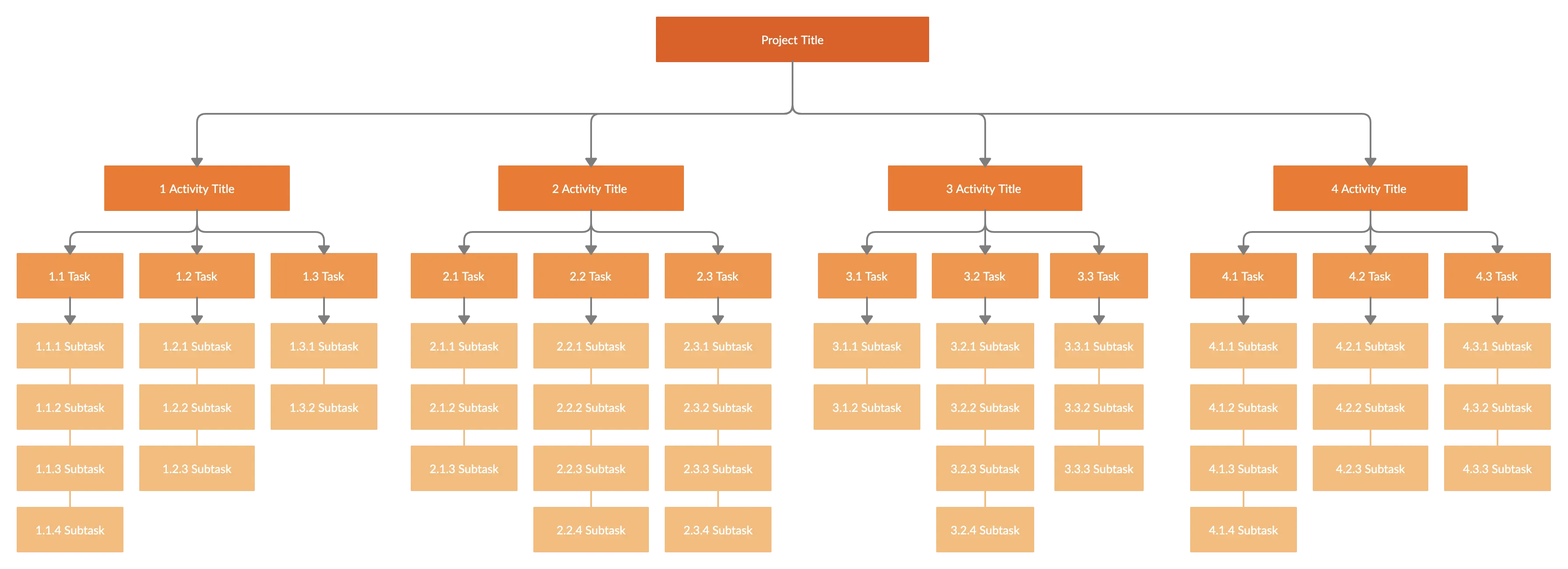
Work Breakdown Structure Example
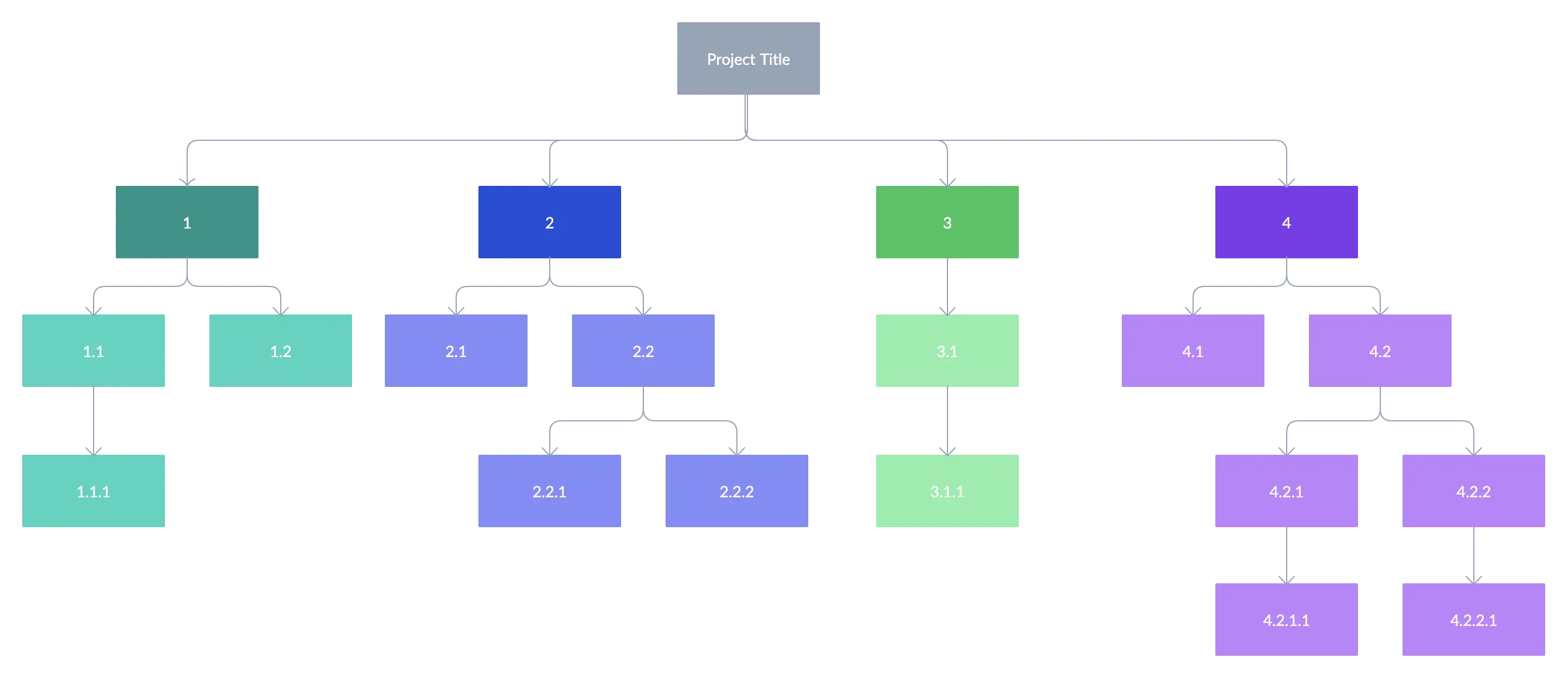
Tabular Work Breakdown Structure Example
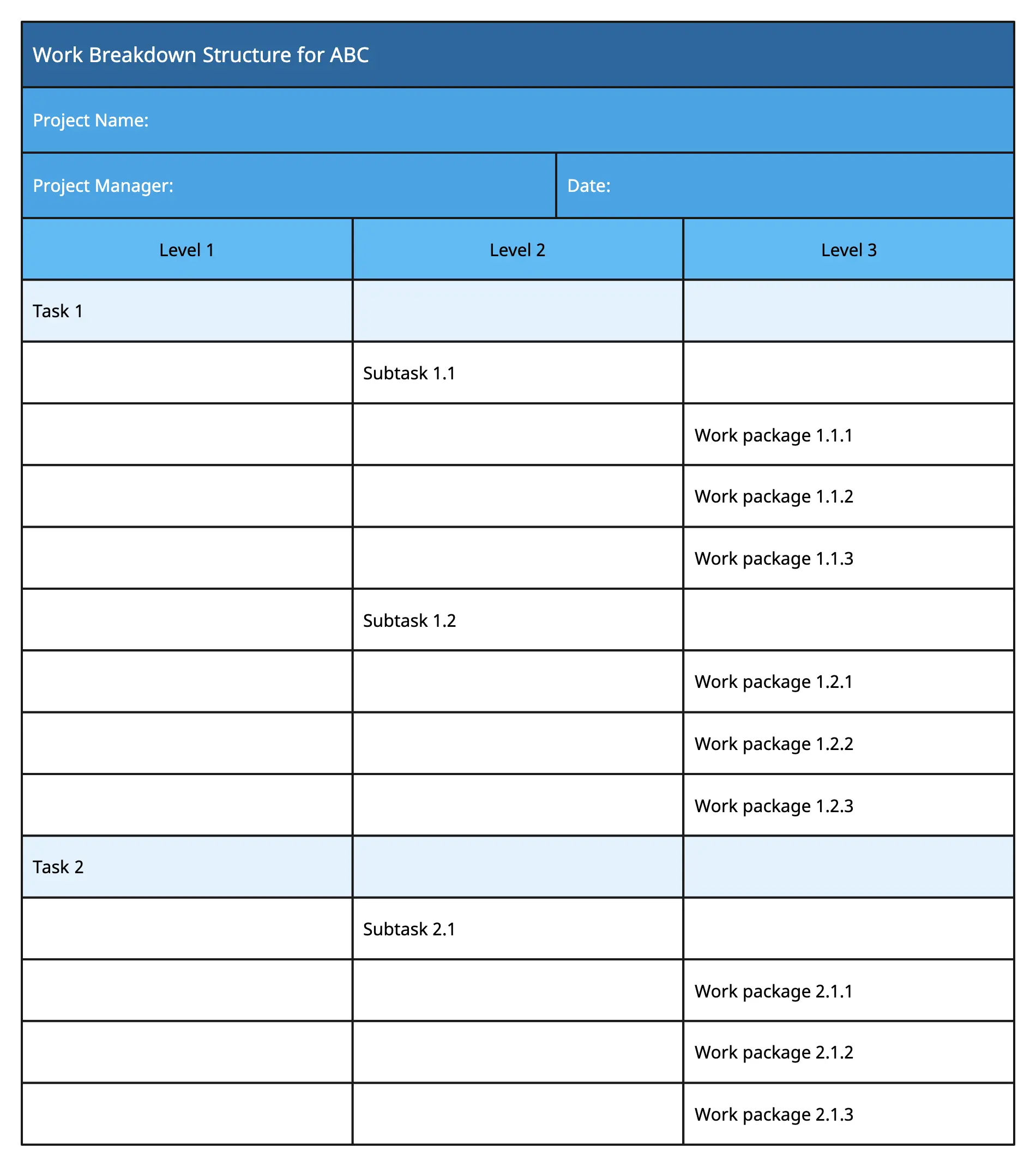
Any Comments on Our Guide to Work Breakdown Structures
Creating a work breakdown structure can be a daunting task. Follow the steps in this guide and make use of the templates to simplify your WBS process.
Got anything to share? Do let us know your thoughts in the comment section below.
FAQs on Work Breakdown Structures
What are the best practices to keep in mind when creating a WBS?
Creating a WBS requires input from a wide range of stakeholders, including project managers, team members, and subject matter experts and it’s crucial to involve them to ensure that the WBS accurately reflects the project’s scope and requirements.
Begin with the project’s major deliverables and work your way down to smaller components. This will help ensure that all work is accounted for and that the WBS is complete.
Use simple, straightforward language that is easy for all stakeholders to understand. Avoid technical jargon or complex terminology that may confuse team members.
Break down work into small, manageable tasks that can be easily tracked and completed. This will help prevent tasks from being overlooked or forgotten.
Ensure that all tasks required to complete the project are included in the WBS.
Use a hierarchical structure that clearly defines the relationship between the project’s major deliverables and the tasks required to complete them.
While it’s important to have a detailed WBS, overcomplicating the structure can make it difficult to understand and manage. Keep the structure simple and straightforward.
Regularly review and update the WBS to ensure that it accurately reflects the project’s scope and progress.
What are the different types of work breakdown structures?
There are two main types of Work Breakdown Structures (WBS):
- Deliverable-based WBS: This type of WBS is organized around the project’s deliverables or outcomes. The project is broken down into a hierarchy of deliverables, each of which is broken down into sub-deliverables and work packages. This type of WBS is useful for projects that have well-defined deliverables or milestones, such as software development or construction projects.
- Phase-based WBS: This type of WBS is organized around the project’s phases or stages. The project is broken down into a hierarchy of phases, each of which is broken down into sub-phases and work packages. This type of WBS is useful for projects that have distinct phases, such as research or consulting projects.
How to use a work breakdown structure?
Project planning: Use the WBS to plan the project’s scope, milestones, and deliverables. The WBS will help you identify all the work that needs to be done and ensure that nothing is overlooked.
Resource allocation: Use the WBS to allocate resources to the project’s tasks and subtasks. This will help ensure that resources are used effectively and efficiently.
Project tracking: Use the WBS to track the project’s progress and ensure that it stays on track. The WBS will help you identify any delays or issues and take corrective action as needed.
Budgeting: Use the WBS to estimate and track the project’s costs. The WBS will help you identify all the costs associated with the project and ensure that the project stays within budget.
Reporting: Use the WBS to report on the project’s progress to stakeholders. The WBS will help you communicate the project’s status, milestones, and deliverables in a clear and concise manner.





